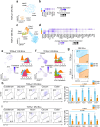Heterogeneity of CD8αα intraepithelial lymphocytes is transcriptionally conserved between TCRαβ and TCRγδ cell lineages
- PMID: 40837586
- PMCID: PMC12361183
- DOI: 10.3389/fimmu.2025.1637209
Heterogeneity of CD8αα intraepithelial lymphocytes is transcriptionally conserved between TCRαβ and TCRγδ cell lineages
Abstract
Intestinal intraepithelial lymphocytes (IELs) are a versatile population of immune cells with both effector and regulatory roles in gut immunity. Although this functional diversity is thought to arise from distinct IEL subpopulations, the heterogeneity of TCRαβ+ and TCRγδ+ IELs have not been well characterized. Using scRNAseq, we identified CD8αα+ T cell subsets with memory-like (Tcf7 +) and effector-like (Prdm1 +) profiles in both TCRαβ+ and TCRγδ+ IELs. Using CD160 and CD122 as markers of memory-like and effector-like cells, respectively, we found that while effector-like cells dominated the small intestine, memory-like IELs were more prevalent in the large intestine, suggesting a functional specialization of immune responses along the gut. Further transcriptional analysis revealed shared profiles between TCRαβ+ and TCRγδ+ small intestinal IEL subsets, suggesting conserved functional roles across these populations. Finally, our analysis indicated that TCRαβ+ memory-like IELs arise from Tcf7+ double-negative (DN) precursors, and that effector-like IELs subsequently differentiate from the memory-like population. In contrast, TCRγδ+ IELs appear to originate from two distinct precursor populations, one expressing Tcf7 and the other Zeb2, indicating the presence of parallel developmental pathways within this lineage. Overall, our findings reveal that both TCRαβ+ and TCRγδ+ cells contain memory-like and effector-like subsets, which may contribute to the functional heterogeneity of IELs.
Keywords: BLIMP1/Prdm1; DN IELs; IEL - intraepithelial lymphocyte; TCF1/Tcf7; Vg7; Zeb2 gene; effector; memory.
Copyright © 2025 Hioki, Liang, Lynch, Ranjan, Pobezinskaya and Pobezinsky.
Conflict of interest statement
The authors declare that the research was conducted in the absence of any commercial or financial relationships that could be construed as a potential conflict of interest. The author(s) declared that they were an editorial board member of Frontiers, at the time of submission. This had no impact on the peer review process and the final decision.
Figures





Update of
-
Heterogeneity of CD8αα intraepithelial lymphocytes is transcriptionally conserved between TCRαβ and TCRγδ cells.bioRxiv [Preprint]. 2025 May 25:2025.05.20.655135. doi: 10.1101/2025.05.20.655135. bioRxiv. 2025. Update in: Front Immunol. 2025 Aug 05;16:1637209. doi: 10.3389/fimmu.2025.1637209. PMID: 40475561 Free PMC article. Updated. Preprint.
Similar articles
-
Heterogeneity of CD8αα intraepithelial lymphocytes is transcriptionally conserved between TCRαβ and TCRγδ cells.bioRxiv [Preprint]. 2025 May 25:2025.05.20.655135. doi: 10.1101/2025.05.20.655135. bioRxiv. 2025. Update in: Front Immunol. 2025 Aug 05;16:1637209. doi: 10.3389/fimmu.2025.1637209. PMID: 40475561 Free PMC article. Updated. Preprint.
-
c-Myc controls the development of CD8alphaalpha TCRalphabeta intestinal intraepithelial lymphocytes from thymic precursors by regulating IL-15-dependent survival.Blood. 2010 Jun 3;115(22):4431-8. doi: 10.1182/blood-2009-11-254698. Epub 2010 Mar 22. Blood. 2010. PMID: 20308599
-
T-bet expressing Tr1 cells driven by dietary signals dominate the small intestinal immune landscape.bioRxiv [Preprint]. 2025 Jul 4:2025.06.30.662190. doi: 10.1101/2025.06.30.662190. bioRxiv. 2025. PMID: 40747421 Free PMC article. Preprint.
-
Development, ontogeny, and maintenance of TCRαβ+ CD8αα IEL.Curr Opin Immunol. 2019 Jun;58:83-88. doi: 10.1016/j.coi.2019.04.010. Epub 2019 May 28. Curr Opin Immunol. 2019. PMID: 31146182 Free PMC article. Review.
-
Intestinal intraepithelial lymphocytes: Maintainers of intestinal immune tolerance and regulators of intestinal immunity.J Leukoc Biol. 2021 Feb;109(2):339-347. doi: 10.1002/JLB.3RU0220-111. Epub 2020 Jul 17. J Leukoc Biol. 2021. PMID: 32678936 Free PMC article. Review.
References
-
- Roberts SJ, Smith AL, West AB, Wen L, Findly RC, Owen MJ, et al. T-cell alpha beta + and gamma delta + deficient mice display abnormal but distinct phenotypes toward a natural, widespread infection of the intestinal epithelium. Proc Natl Acad Sci U.S.A. (1996) 93:11774–9. doi: 10.1073/pnas.93.21.11774, PMID: - DOI - PMC - PubMed
MeSH terms
Substances
Grants and funding
LinkOut - more resources
Full Text Sources
Research Materials

